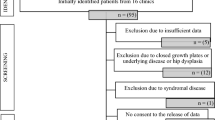Abstract
Background
Traumatic hip dislocation in childhood is a rare consequence of violent trauma. After reduction, outcome is usually favourable although epiphyseal necrosis can occur. Reduction must be carried out as soon as possible and is achieved easily, although if the labrum is involved, surgery may be required to achieve complete reduction.
Objective
To analyze a retrospective series of traumatic hip dislocations in children, describing the therapeutic and imaging strategy.
Materials and methods
A total of 42 patients were studied. Their mean age was 10 years 3 months. All relevant radiographic, CT, MRI and radionuclide bone scan examinations were reviewed. Special attention was paid to associated lesions.
Results
In 22 patients the dislocation was caused by low-energy trauma. Road traffic accidents accounted for 17 dislocations. An acetabular fracture was present in six patients and the femoral head was fractured in three. Reduction was easily achieved in 31 patients. In 11 patients the postreduction radiograph and CT showed joint space asymmetry secondary to labral entrapment. Only two patients developed epiphyseal necrosis.
Conclusions
It has been difficult to define and evaluate accurate principles for a medical imaging strategy in this group of patients. Analysis of plain radiographs is essential before and after reduction of the joint, and it is important to perform postreduction CT in every patient whose joint space remains widened. A radionuclide bone scan should be performed between the second and third weeks after injury to assess epiphyseal vascularity. With the use of specific sequences, MRI may be an alternative modality to assess epiphyseal vitality.












Similar content being viewed by others
References
Freeman G (1961) Traumatic dislocation of the hip in children. A report of seven cases and review of the literature. J Bone Joint Surg Am 43A:401–406
Hamilton PR, Broughton NS (1998) Traumatic hip dislocation in childhood. J Pediatr Orthop 18:691–694
Macfarlane I, King D (1976) Traumatic dislocation of the hip joint in children. Aust N Z J Surg 46:227–231
Pearson DE, Mann RJ (1973) Traumatic hip dislocation in children. Clin Orthop 92:189–194
Rieger H, Pennig D, Klein W, et al (1991) Traumatic dislocation of the hip in young children. Arch Orthop Trauma Surg 110:114–117
Harris WH (1969) Traumatic arthritis of the hip after dislocation and acetabular fractures: treatment by mold arthroplasty. An end-result study using a new method of result evaluation. J Bone Joint Surg Am 51:737–755
Barquet A (1979) Traumatic hip dislocation in childhood. A report of 26 cases and review of the literature. Acta Orthop Scand 50:549–553
Frick SL, Sims SH (1995) Is computed tomography useful after simple posterior hip dislocation? J Orthop Trauma 9:388–391
Mehlman CT, Hubbard GW, Crawford AH, et al (2000) Traumatic hip dislocation in children. Long-term follow-up of 42 patients. Clin Orthop 376:68–79
Tornetta P III, Mostafavi HR (1997) Hip dislocation: current treatment regimens. J Am Acad Orthop Surg 5:27–36
Rubel IF, Kloen P, Potter HG, et al (2002) MRI assessment of the posterior acetabular wall fracture in traumatic dislocation of the hip in children. Pediatr Radiol 32:435–439
Odent T, Glorion C, Pannier S, et al (2003) Traumatic dislocation of the hip with separation of the capital epiphysis: 5 adolescent patients with 3–9 years of follow-up. Acta Orthop Scand 74:49–52
Powers JA, Bach PJ (1977) Coxa magna. South Med J 70:1297–1299
Mahnken AH, Staatz G, Ihme N, et al (2002) MR signal intensity characteristics in Legg-Calve-Perthes disease. Value of fat-suppressed (STIR) images and contrast-enhanced T1-weighted images. Acta Radiol 43:329–335
Sebag G, Ducou Le Pointe H, Klein I, et al (1997) Dynamic gadolinium-enhanced subtraction MR imaging—a simple technique for the early diagnosis of Legg-Calve-Perthes disease: preliminary results. Pediatr Radiol 27:216–220
Ducou le Pointe H, Haddad S, Silberman B, et al (1994) Legg-Perthes-Calve disease: staging by MRI using gadolinium. Pediatr Radiol 24:88–91
Lamer S, Dorgeret S, Khairouni A, et al (2002) Femoral head vascularisation in Legg-Calve-Perthes disease: comparison of dynamic gadolinium-enhanced subtraction MRI with bone scintigraphy. Pediatr Radiol 32:580–585
Gennari JM, Merrot T, Bergoin V, et al (1996) X-ray transparency interpositions after reduction of traumatic dislocations of the hip in children. Eur J Pediatr Surg 6:288–293
Offierski CM (1981) Traumatic dislocation of the hip in children. J Bone Joint Surg Br 63B:194–197
Author information
Authors and Affiliations
Corresponding author
Rights and permissions
About this article
Cite this article
Vialle, R., Pannier, S., Odent, T. et al. Imaging of traumatic dislocation of the hip in childhood. Pediatr Radiol 34, 970–979 (2004). https://doi.org/10.1007/s00247-004-1299-0
Received:
Revised:
Accepted:
Published:
Issue Date:
DOI: https://doi.org/10.1007/s00247-004-1299-0




